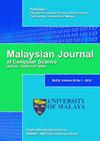PREDICTION OF CONGESTIONS USING BASIC TRAFFIC UNIT
IF 1.2
4区 计算机科学
Q4 COMPUTER SCIENCE, ARTIFICIAL INTELLIGENCE
引用次数: 0
Abstract
In any form of traffic, whether it is physical or digital, the main problem that sparks a lot of interest for researchers is congestion. This paper discusses a study of congestion around toll plazas. A newly formulated model called Basic Traffic Unit (BTU) is introduced from previous research. BTU is a representation of a basic network connected to form a larger network. A simulation study is conducted and some queuing theories are applied to calculate the measure of performance. Two sets of data from different modes of toll payment are collected. The same two types of payments are simulated and the measure of performance is recorded. The two types of payments from the collected real data are used to calculate the measure of performance using the formula developed by the BTU. This study demonstrates that the results from simulated data can be used to compare with the results from the real-time data using the formula developed by a static model of BTU to predict possible congestions. Comparing results from both methods validates the claim that BTU is useful for predicting congestions.基于基本交通单元的交通拥堵预测
在任何形式的交通中,无论是物理的还是数字的,引起研究人员极大兴趣的主要问题是拥堵。本文对收费广场周围的拥堵问题进行了研究。在前人研究的基础上,提出了一种新的交通流量单位(BTU)模型。BTU是一个基本网络的表示,它连接起来形成一个更大的网络。进行了仿真研究,并应用排队理论计算了性能度量。收集了两组不同收费方式的数据。模拟了同样的两种支付方式,并记录了绩效衡量标准。根据收集到的真实数据,这两种类型的支付被用来使用由BTU开发的公式来计算绩效指标。本研究表明,模拟数据的结果可以与实时数据的结果进行比较,使用静态BTU模型开发的公式来预测可能的拥堵。比较两种方法的结果验证了BTU对预测拥堵有用的说法。
本文章由计算机程序翻译,如有差异,请以英文原文为准。
求助全文
约1分钟内获得全文
求助全文
来源期刊

Malaysian Journal of Computer Science
COMPUTER SCIENCE, ARTIFICIAL INTELLIGENCE-COMPUTER SCIENCE, THEORY & METHODS
CiteScore
2.20
自引率
33.30%
发文量
35
审稿时长
7.5 months
期刊介绍:
The Malaysian Journal of Computer Science (ISSN 0127-9084) is published four times a year in January, April, July and October by the Faculty of Computer Science and Information Technology, University of Malaya, since 1985. Over the years, the journal has gained popularity and the number of paper submissions has increased steadily. The rigorous reviews from the referees have helped in ensuring that the high standard of the journal is maintained. The objectives are to promote exchange of information and knowledge in research work, new inventions/developments of Computer Science and on the use of Information Technology towards the structuring of an information-rich society and to assist the academic staff from local and foreign universities, business and industrial sectors, government departments and academic institutions on publishing research results and studies in Computer Science and Information Technology through a scholarly publication. The journal is being indexed and abstracted by Clarivate Analytics'' Web of Science and Elsevier''s Scopus
 求助内容:
求助内容: 应助结果提醒方式:
应助结果提醒方式:


